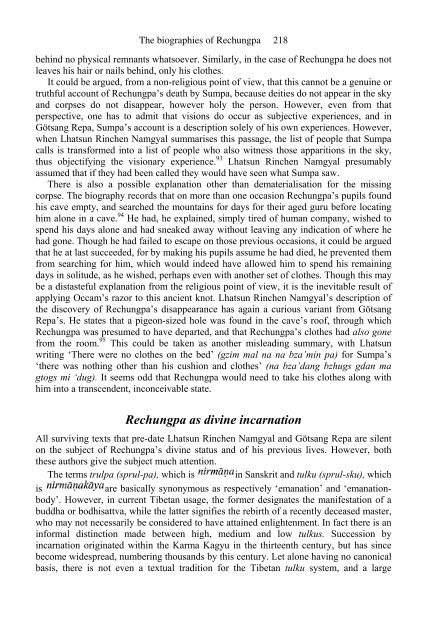The Biographies of Rechungpa: The Evolution of a Tibetan ...
The Biographies of Rechungpa: The Evolution of a Tibetan ...
The Biographies of Rechungpa: The Evolution of a Tibetan ...
You also want an ePaper? Increase the reach of your titles
YUMPU automatically turns print PDFs into web optimized ePapers that Google loves.
<strong>The</strong> biographies <strong>of</strong> <strong>Rechungpa</strong> 218<br />
behind no physical remnants whatsoever. Similarly, in the case <strong>of</strong> <strong>Rechungpa</strong> he does not<br />
leaves his hair or nails behind, only his clothes.<br />
It could be argued, from a non-religious point <strong>of</strong> view, that this cannot be a genuine or<br />
truthful account <strong>of</strong> <strong>Rechungpa</strong>’s death by Sumpa, because deities do not appear in the sky<br />
and corpses do not disappear, however holy the person. However, even from that<br />
perspective, one has to admit that visions do occur as subjective experiences, and in<br />
Götsang Repa, Sumpa’s account is a description solely <strong>of</strong> his own experiences. However,<br />
when Lhatsun Rinchen Namgyal summarises this passage, the list <strong>of</strong> people that Sumpa<br />
calls is transformed into a list <strong>of</strong> people who also witness those apparitions in the sky,<br />
thus objectifying the visionary experience. 93 Lhatsun Rinchen Namgyal presumably<br />
assumed that if they had been called they would have seen what Sumpa saw.<br />
<strong>The</strong>re is also a possible explanation other than dematerialisation for the missing<br />
corpse. <strong>The</strong> biography records that on more than one occasion <strong>Rechungpa</strong>’s pupils found<br />
his cave empty, and searched the mountains for days for their aged guru before locating<br />
him alone in a cave. 94 He had, he explained, simply tired <strong>of</strong> human company, wished to<br />
spend his days alone and had sneaked away without leaving any indication <strong>of</strong> where he<br />
had gone. Though he had failed to escape on those previous occasions, it could be argued<br />
that he at last succeeded, for by making his pupils assume he had died, he prevented them<br />
from searching for him, which would indeed have allowed him to spend his remaining<br />
days in solitude, as he wished, perhaps even with another set <strong>of</strong> clothes. Though this may<br />
be a distasteful explanation from the religious point <strong>of</strong> view, it is the inevitable result <strong>of</strong><br />
applying Occam’s razor to this ancient knot. Lhatsun Rinchen Namgyal’s description <strong>of</strong><br />
the discovery <strong>of</strong> <strong>Rechungpa</strong>’s disappearance has again a curious variant from Götsang<br />
Repa’s. He states that a pigeon-sized hole was found in the cave’s ro<strong>of</strong>, through which<br />
<strong>Rechungpa</strong> was presumed to have departed, and that <strong>Rechungpa</strong>’s clothes had also gone<br />
from the room. 95 This could be taken as another misleading summary, with Lhatsun<br />
writing ‘<strong>The</strong>re were no clothes on the bed’ (gzim mal na na bza’min pa) for Sumpa’s<br />
‘there was nothing other than his cushion and clothes’ (na bza’dang bzhugs gdan ma<br />
gtogs mi ‘dug). It seems odd that <strong>Rechungpa</strong> would need to take his clothes along with<br />
him into a transcendent, inconceivable state.<br />
<strong>Rechungpa</strong> as divine incarnation<br />
All surviving texts that pre-date Lhatsun Rinchen Namgyal and Götsang Repa are silent<br />
on the subject <strong>of</strong> <strong>Rechungpa</strong>’s divine status and <strong>of</strong> his previous lives. However, both<br />
these authors give the subject much attention.<br />
<strong>The</strong> terms trulpa (sprul-pa), which is in Sanskrit and tulku (sprul-sku), which<br />
is are basically synonymous as respectively ‘emanation’ and ‘emanationbody’.<br />
However, in current <strong>Tibetan</strong> usage, the former designates the manifestation <strong>of</strong> a<br />
buddha or bodhisattva, while the latter signifies the rebirth <strong>of</strong> a recently deceased master,<br />
who may not necessarily be considered to have attained enlightenment. In fact there is an<br />
informal distinction made between high, medium and low tulkus. Succession by<br />
incarnation originated within the Karma Kagyu in the thirteenth century, but has since<br />
become widespread, numbering thousands by this century. Let alone having no canonical<br />
basis, there is not even a textual tradition for the <strong>Tibetan</strong> tulku system, and a large











